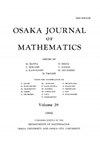尖刃与燕尾的局部微分几何
IF 0.4
4区 数学
Q3 MATHEMATICS
引用次数: 15
摘要
从奇异性理论的角度研究了尖边和燕尾的局部微分几何不变量。基于尖边和燕尾的某些正规形式,我们引入了这种奇点的有限型不变量(见注1.5和定理2.11)。然后,我们讨论了基于我们的正规形式的几个几何方面,并给出了关于我们的不变量关于高斯曲率和平均曲率的几个渐近公式。波前的典型例子是三维欧几里得空间中规则表面的平行表面,众所周知,这种表面可能具有几个奇点,如尖边和燕尾。[3]研究了平行曲面的奇异性类型,下一个兴趣是研究这种奇异性的局部微分几何。有几种尝试来描述它们。例如,K.Saji、M.Umehara和K.Yamada([12])定义了尖边的奇异曲率κs和法向曲率κΓ的概念,后来K.Saji和L.Martins([7])描述了所有3阶不变量。很明显,在高阶项中有更多的微分几何不变量,并且将所有这些不变量描述到有限阶是本文的动机之一。由于高斯曲率和平均曲率经常在奇点处发散,我们对它们在奇点附近的不变量的渐近行为感兴趣。我们将描述燕尾附近尖边的局部微分几何不变量的渐近行为。奇异性理论的一个思想是减少给定的映射胚(R2,0)→ (R3,0)转化为某种正态(例如参见[9])。它们的正常形式可在-等效,其中 是源和目标的坐标变化组。在这种情况下,我们将给定的映射胚简化为列表中的一种法线形式,构成源和目标的某些坐标变化。出于微分几何的目的,目标的一般坐标变化过于粗糙,因为它们没有保留微分几何特性,并且我们应该将目标的坐标变化限制在运动组中。从这一点出发,我们将考虑源的坐标变化与目标的运动群(当我们考虑映射芽时的旋转群)的乘积群,并通过该群定义的等价关系引入尖边(见(1.1))和燕尾(定理2.4)的一种法线形式。我们相信这是一种研究奇异曲面的强大方法,因为这无法描述所有微分几何2010数学主题分类。初级57R45;二级53A05。在西村隆教授60岁生日之际向他致敬。本文章由计算机程序翻译,如有差异,请以英文原文为准。
Local differential geometry of cuspidal edge and swallowtail
We investigate the local differential geometric invariants of cuspidal edge and swallowtail from the view point of singularity theory. We introduce finite type invariants of such singularities (see Remark 1.5 and Theorem 2.11) based on certain normal forms for cuspidal edge and swallowtail. Then we discuss several geometric aspects based on our normal form. We also present several asymptotic formulas concerning our invariants with respect to Gauss curvature and mean curvature. Typical examples of wave fronts are parallel surfaces of a regular surface in the 3dimensional Euclidean space, and it is well-known that such surfaces may have several singularities like cuspidal edge and swallowtail. Singularity types of parallel surfaces are investigated in [3], and the next interest is to investigate local differential geometries of such singularities. There are several attempts to describe them. For instance, K. Saji, M. Umehara, and K. Yamada ([12]) defined the notion of singular curvature κs and normal curvature κν of cuspidal edge, and, later, K. Saji and L. Martins ([7]) described all invariants up to order 3. It is clear that there are more differential geometric invariants in higher order terms, and to describe all such invariants up to finite order is one motivation of the paper. Since Gauss curvature and mean curvature are often diverge at singularities and we are interested in their asymptotic behaviors near a singularity in terms of our invariants. We are going to describe their asymptotic behaviors of our local differential geometric invariants of cuspidal edge near swallowtail. An ideas of singularity theory is to reduce a given map-germ (R2, 0) → (R3, 0) to certain normal form (see [9], for example). Their normal forms are obtained up to -equivalence where is the group of coordinate changes of the source and the target. In that context, we reduce a given map-germ to one of normal forms in the list there, composing certain coordinate changes of the source and the target. For differential geometric purpose, general coordinate changes of the target are too rough, since they do not preserve differential geometric properties, and we should restrict the coordinate change of the target to the motion group. From this point, we will consider the product group of coordinate change of the source with the motion group of the target (the rotation group when we consider map-germs) and we introduce a normal form for cuspidal edge (see (1.1)) and swallowtail (Theorem 2.4) by the equivalence relation defined by this group. We believe that this is a powerful method to investigate singular surfaces, since this unable us to describe all differential geometric 2010 Mathematics Subject Classification. Primary 57R45; Secondary 53A05. Dedicated to Professor Takashi Nishimura on the occasion of his 60th birthday.
求助全文
通过发布文献求助,成功后即可免费获取论文全文。
去求助
来源期刊
CiteScore
0.90
自引率
0.00%
发文量
0
审稿时长
>12 weeks
期刊介绍:
Osaka Journal of Mathematics is published quarterly by the joint editorship of the Department of Mathematics, Graduate School of Science, Osaka University, and the Department of Mathematics, Faculty of Science, Osaka City University and the Department of Pure and Applied Mathematics, Graduate School of Information Science and Technology, Osaka University with the cooperation of the Department of Mathematical Sciences, Faculty of Engineering Science, Osaka University. The Journal is devoted entirely to the publication of original works in pure and applied mathematics.

 求助内容:
求助内容: 应助结果提醒方式:
应助结果提醒方式:


